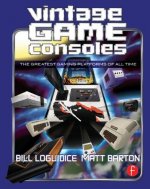Bill_Loguidice
Veteran Member
Many of you already know about this, but just in case, I wanted to start the topic for my upcoming book, Vintage Game Consoles: An Inside Look at Apple, Atari, Commodore, Nintendo, and the Greatest Gaming Platforms of All Time, which will be released in February, but is available for pre-order now. This is the next entry in the Focal Press Vintage Games series, which started with the critically acclaimed 2009 release, Vintage Games: An Insider Look at the History of Grand Theft Auto, Super Mario, and the Most Influential Games of All Time. In contrast to Vintage Games, which covered 35 of the most influential computer, console, and handheld games of all time (up to the book's publication date), Vintage Game Consoles covers 20 of the greatest game playing computer, console, and handheld platforms of all time (up to 2001, which means no platforms still actively sold (i.e., their history is still being written)). It's full color throughout, with 400 images, an extensive preface, and major section introductions to complement each platform chapter, which provides a thorough history of the industry through the lens of the very platforms that helped define it. Any questions? Ask away! (also be sure to check out my other recently released book, CoCo: The Colorful History of Tandy's Underdog Computer, and the next book to see release after Vintage Game Consoles, My Xbox One; March will also see the first unveiling of our major feature film documentary on the history of videogames (based loosely on the Vintage Games series books), Gameplay: The Story of the Videogame Revolution)
Contents:
Preface
Generation One (1971 – 1984)
Arcade (1971)
Apple II (1977)
Atari 2600 VCS (1977)
Atari 8-bit (1979)
Mattel Intellivision (1979)
PC DOS Computers (1981)
Commodore 64 (1982)
Coleco ColecoVision (1982)
Generation Two (1985 – 1994)
Nintendo Entertainment System (1985)
Commodore Amiga (1985)
Sega Genesis (1989)
Nintendo GameBoy (1989)
Nintendo Super NES (1991)
Generation Three (1995 – 2001)
PC Windows Computers (1995)
Sony PlayStation (1995)
Nintendo 64 (1996)
Sega Dreamcast (1999)
Sony PlayStation 2 (2000)
Microsoft Xbox (2001)
Nintendo GameCube (2001)
The cover art is by Nathan Strum, renowned homebrew cover artist. For those not familiar with the style, it's meant to evoke my first (and favorite) childhood magazine, Electronic Games. I think he nailed it:

Contents:
Preface
Generation One (1971 – 1984)
Arcade (1971)
Apple II (1977)
Atari 2600 VCS (1977)
Atari 8-bit (1979)
Mattel Intellivision (1979)
PC DOS Computers (1981)
Commodore 64 (1982)
Coleco ColecoVision (1982)
Generation Two (1985 – 1994)
Nintendo Entertainment System (1985)
Commodore Amiga (1985)
Sega Genesis (1989)
Nintendo GameBoy (1989)
Nintendo Super NES (1991)
Generation Three (1995 – 2001)
PC Windows Computers (1995)
Sony PlayStation (1995)
Nintendo 64 (1996)
Sega Dreamcast (1999)
Sony PlayStation 2 (2000)
Microsoft Xbox (2001)
Nintendo GameCube (2001)
The cover art is by Nathan Strum, renowned homebrew cover artist. For those not familiar with the style, it's meant to evoke my first (and favorite) childhood magazine, Electronic Games. I think he nailed it:

